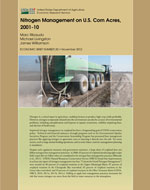Nitrogen Management on U.S. Corn Acres, 2001-10
by
Marc Ribaudo,
Michael Livingston, and
James WilliamsonEconomic Brief No. (EB-20) 6 pp, November 2012
 Nitrogen is a critical input in agriculture, enabling farmers to produce high crop yields profitably. However, nitrogen compounds released into the environment are a source of environmental problems, including eutrophication and hypoxia in aquatic ecosystems, visibility-impairing haze, and the loss of biodiversity. Improved nitrogen management on cropland has been a longstanding goal of USDA conservation policy. Technical and financial assistance have promoted best management practices like applying nitrogen at agronomic rates or injecting it directly into the soil. Perhaps because of these government program measures and changing economic conditions, the use of best nitrogen management practices has improved since 2001, although excessive amounts of nitrogen continued to be applied on 31 percent of corn acres in 2010.
Nitrogen is a critical input in agriculture, enabling farmers to produce high crop yields profitably. However, nitrogen compounds released into the environment are a source of environmental problems, including eutrophication and hypoxia in aquatic ecosystems, visibility-impairing haze, and the loss of biodiversity. Improved nitrogen management on cropland has been a longstanding goal of USDA conservation policy. Technical and financial assistance have promoted best management practices like applying nitrogen at agronomic rates or injecting it directly into the soil. Perhaps because of these government program measures and changing economic conditions, the use of best nitrogen management practices has improved since 2001, although excessive amounts of nitrogen continued to be applied on 31 percent of corn acres in 2010.
Keywords: Corn, nitrogen, Agricultural Resource Management Survey, nitrogen management, conservation programs
In this publication...
Charts and graphs (in .png format) from this report are available in the .zip file listed below. The .zip file also contains a document (readme.txt) that lists the name and title of each chart or graph file.
Need help with PDFs?
Order this Publication